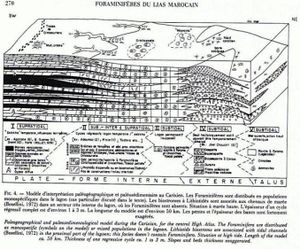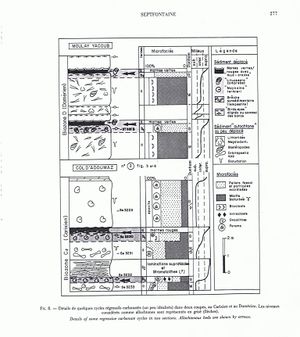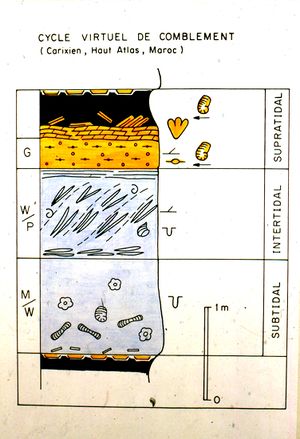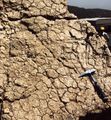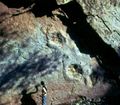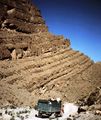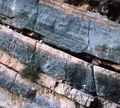دورة ترسيب
دورة الترسيب Cyclic sediments، هي تتابع رأسي من الصخور الرسوبية، تكون أثناء دورة طغيان - انحسار البحر transgressive - regressive cycle.[1]
العمليات التي تنشئ دورة الترسيب
دورات تلقائية
Autocycles are sedimentary cycles that are created by processes that only take place within the basin of deposition and that involve free oscillations of the sedimentary system; indeed, the resulting cyclic succession is only function of the geometrical and sedimentary parameters characteristic of the depositional system (e.g.: shelf dimension and shape, carbonate productivity, etc.). Autocycles show limited stratigraphic continuity.[2]
An example of autocyclic sedimentation on a carbonate platform was provided by Septfontaine M. (1985): Depositional environments and associated foraminifera (lituolids) in the middle liasic carbonate platform of Morocco.- Rev. de Micropal., 28/4, 265-289. See also www.palgeo.ch/publications.
Top of a metric regressive cycle with desiccations, surface of bed dolomitised. Middle liassic of the High Atlas, Morocco.
Allocycles
Allocycles are sedimentary cycles caused by processes outside of the depositional system and that involve forced oscillations of the sedimentary system; in this case the cyclic succession registers some features of the forcing process (Sea level fluctuations, climate oscillations or tectonic activity). Allocyclic successions can extend over great distances and are not limited to a single depositional basin[2].
Changes in sea level can create cyclic successions of limestones, shales, coals and seat earths. For these cycles to have been formed, the environment at the site of deposition must have been changing radically from marine to deltaic, then lagoonal and then continental. One cause of sea level change is the expansion or shrinking of continental glaciers caused by climate change. Tectonic movements can affect the environment of deposition as well, by changing the local relative sea level. Metric sedimentary cycles could be related to an astronomical (Milankovitch) influence on 20.000 to 400000 years time scales (see Cyclostratigraphy). But these beds are of no use in correlation and should not be taken as a "high resolution" tool for stratigraphy without a severe biostratigraphic control.
Seasonal changes in weather can create cyclic sediments in the form of alternating bands of clay and silt (also known as varves). For example, in a glacial region where sediments are deposited in a lake, coarse sediments that are trapped in ice are released when the ice melts in the summer. This creates paler, coarser silt bands in the lake deposits. In winter, melting is at a minimum, meaning that only fine material is supplied to the lake, causing thin clay layers. Varves form through an allocyclic process, but because the cycles are limited to the depositional basin, the lateral extent of the resultant strata are limited.
مشكلات دراسة دورة الترسيب
المصادر
• Septfontaine, M. (1985): Milieux de dépôts et foraminifères (Lituolidae) de la plate-forme carbonatée du Lias moyen au Maroc.- Rev. Micropaléont., 28/4, 265-289. (Le modèle ancien proposé ci-dessous a son équivalent actuel au fond du golfe de Gabès et dans les chotts associés, voir Davaud & Septfontaine, 1995.
• Davaud, E. & Septfontaine, M. (1995): Post-Mortem onshore transportation of epiphytic foraminifera: recent example from the Tunisian coastline.- Jour. Sediment. Research, 65/1A, 136-142.
• Septfontaine, M. & De Matos, E. (1998): Pseudodictyopsella jurassica nov. gen., nov. sp., a new foraminifera from the Earlay Middle Jurassic of the Musandam Peninsula. Sedimentological and stratigraphical context.- Rev. Micropaléont., 41/1,71-87. (Dans cet article, on note l'absence du genre Orbitammina en Oman, souvent confondu avec Timidonella par les auteurs anglo-saxons).
- ^ عبد الجليل هويدي، محمد أحمد هيكل (2004). أساسيات الجيولوجيا التاريخية. مكتبة الدار العربية للكتب.
- ^ أ ب Flugel, Erik (2004-09-15). Microfacies of Carbonate Rocks. Springer. ISBN 978-3-540-22016-9.
